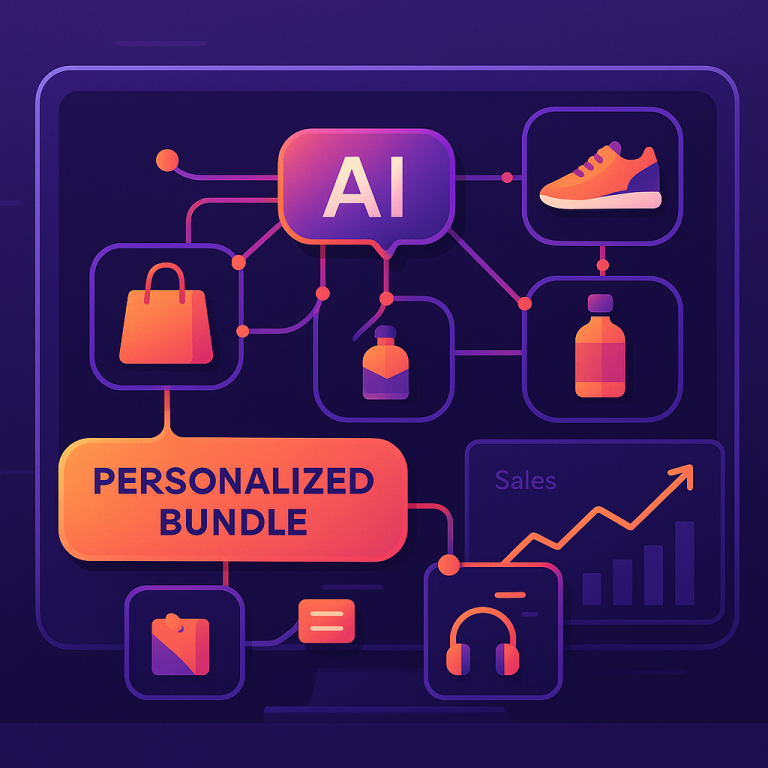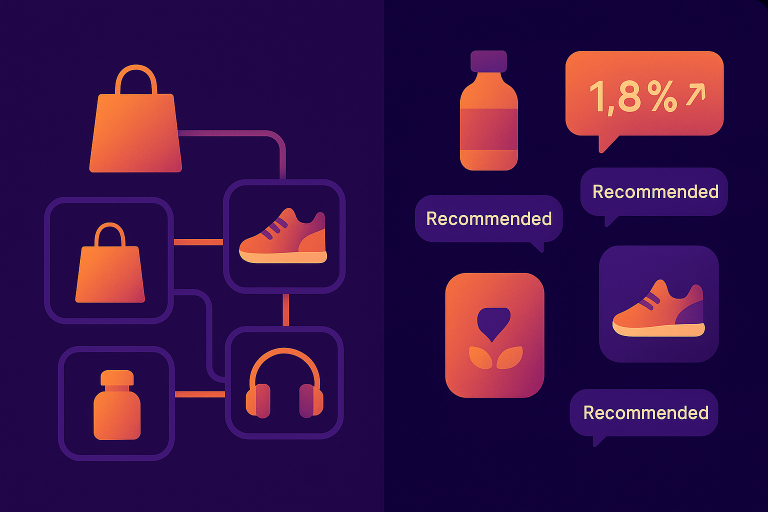How AI Creates Perfect Product Bundles Automatically
In today’s competitive e-commerce landscape, businesses are constantly searching for innovative ways to increase sales, improve customer satisfaction, and streamline operations. AI-generated product bundles have emerged as a powerful strategy that accomplishes all three objectives simultaneously. By leveraging advanced algorithms to automatically create optimized product combinations, businesses can offer customers more value while boosting their bottom line.
The statistics speak for themselves: companies implementing AI-bundling solutions have seen average order value increases of up to 35%, improved inventory turnover by 25%, and significantly enhanced customer satisfaction scores. But how exactly does this technology work, and how can your business harness its potential?

Understanding AI-Generated Product Bundles
Before diving into implementation strategies, it’s essential to understand what makes AI-generated product bundles different from traditional bundling approaches, and why they’re revolutionizing e-commerce operations worldwide.
Definition and Concept
AI-generated product bundles are curated combinations of items automatically selected by artificial intelligence algorithms based on data analysis, customer behavior patterns, and business objectives. Unlike traditional bundling, which typically relies on merchandiser intuition or basic sales analysis, AI bundles are created through sophisticated computational processes that can identify non-obvious product relationships across thousands or even millions of SKUs.
The evolution from manual to algorithmic bundling represents a fundamental shift in how retailers approach product grouping:
- Traditional bundling: Manually created by merchandisers based on intuition, basic sales data, and category relationships
- Rule-based bundling: Semi-automated approaches using predefined business rules and basic if-then logic
- AI-powered bundling: Fully automated, data-driven combinations optimized through machine learning that continuously improve through feedback loops
The core technologies enabling automatic bundle creation include machine learning algorithms for customer segmentation, natural language processing for product attribute analysis, and advanced predictive analytics that can forecast which combinations will resonate with specific customer segments.
Benefits Over Traditional Bundling Methods
The advantages of AI-generated product bundles extend well beyond operational efficiency, though that alone would justify the investment for many businesses.
| Traditional Bundling | AI-Generated Bundling |
|---|---|
| Limited to dozens or hundreds of manual combinations | Can generate thousands of optimized bundles automatically |
| Static bundles requiring manual updates | Dynamic bundles that adapt to inventory, seasonality, and trends |
| One-size-fits-all approach for all customers | Personalized recommendations based on individual preferences |
| Relies on merchandiser intuition | Driven by comprehensive data analysis and pattern recognition |
| Slow to adapt to market changes | Real-time optimization based on current conditions |
Perhaps most importantly, AI-powered bundling can scale indefinitely as your product catalog grows, maintaining optimization even as complexity increases. This enables enterprises to maintain personalization at scale—a critical competitive advantage in today’s market.
How AI Creates Perfect Product Combinations
The magic behind AI-generated product bundles lies in sophisticated algorithms that identify relationships between products that humans might miss. Let’s explore the technical foundation that makes this possible.
Machine Learning Algorithms for Product Affinity
Several types of algorithms work together to identify ideal product combinations:
- Association rule mining: Identifies products frequently purchased together (the famous “beer and diapers” discovery was an early example of this approach)
- Collaborative filtering: Recommends products based on similar customer purchase patterns (“customers who bought this also bought…”)
- Content-based filtering: Analyzes product attributes and features to recommend complementary items
- Deep learning networks: Advanced neural networks that can identify complex, non-linear relationships between products
Particularly powerful are product embedding models that translate product characteristics into multidimensional vector spaces, allowing algorithms to mathematically calculate similarity and complementarity between seemingly unrelated items.
Data Sources That Power Bundle Recommendations
The effectiveness of AI-generated bundles depends heavily on the quality and diversity of data they’re trained on. The most successful implementations leverage multiple data sources:
- Transactional data: Historical purchase records showing which products are bought together
- Browsing behavior: Click patterns, page views, and time spent examining products
- Search queries: What customers are actively looking for
- Customer profiles: Demographics, purchase history, and segment information
- Inventory data: Stock levels, turnover rates, and margin information
- Seasonal trends: Historical patterns of seasonal demand
- Market basket analysis: Statistical analysis of products purchased in the same transaction
These diverse data streams enable AI systems to build a comprehensive understanding of product relationships that far exceeds what manual analysis could achieve.
Bundle Optimization Parameters
Beyond simply identifying products that go well together, sophisticated AI bundling systems optimize for multiple business objectives simultaneously:
- Price sensitivity modeling: Calculating optimal bundle discounts that maximize conversion while preserving margins
- Complementary vs. supplementary selection: Balancing between items that work together (complementary) and alternative options (supplementary)
- Inventory considerations: Promoting slow-moving inventory without compromising bundle attractiveness
- Seasonality adjustments: Automatically adapting bundles based on time of year, events, or weather patterns
- Margin optimization: Creating bundles that balance high and low-margin products to maintain profitability
The true power of AI in product lifecycle management comes from its ability to continuously optimize these parameters in real-time, creating dynamic bundles that evolve as conditions change.

Business Benefits of AI-Generated Bundles
The implementation of AI-powered bundling strategies delivers measurable business outcomes across multiple dimensions of e-commerce operations.
Increasing Average Order Value
The most immediate benefit of AI-generated bundles is typically seen in average order value (AOV) increases. Data from multiple implementations shows:
- 25-35% increase in AOV when AI-optimized bundles are prominently displayed
- 15-20% higher conversion rates on bundle pages compared to individual product pages
- 40% increase in cross-category purchases, expanding customer relationship with the brand
These improvements stem from the AI’s ability to suggest truly relevant complementary products rather than generic upsells. When customers perceive genuine value in a bundle, their resistance to increasing order size diminishes significantly.
Inventory Management Optimization
AI bundling strategies can transform inventory management by:
- Accelerating turnover of slow-moving stock by pairing it with popular items
- Reducing storage costs by moving seasonal products before they require long-term storage
- Decreasing the need for steep discounts on aging inventory
- Creating demand predictability that improves supply chain planning
By integrating inventory status into bundling algorithms, businesses can achieve a more balanced stock profile while maximizing the value extracted from each product.
Customer Experience Enhancement
Perhaps the most valuable long-term benefit comes from improved customer experience:
- Convenience: Customers appreciate not having to search for complementary items
- Discovery: Bundles introduce customers to products they might otherwise miss
- Personalization: AI-tailored bundles make customers feel understood and valued
- Value perception: Bundle discounts create a sense of smart shopping and savings
The data supports these improvements, with businesses implementing AI bundling reporting 18-23% higher customer satisfaction scores and repeat purchase rates increasing by up to 30% among bundle buyers.
Implementing AI Bundling in Your Business
Moving from concept to implementation requires careful planning, appropriate technology selection, and a clear roadmap.
Technical Requirements and Platform Options
Several approaches exist for implementing AI bundling, each with different requirements:
| Implementation Approach | Technical Requirements | Best For |
|---|---|---|
| SaaS Bundling Solutions | API integration, data export capabilities | Mid-sized merchants seeking fast deployment |
| E-commerce Platform Extensions | Compatible e-commerce platform, extension installation | Small to mid-sized businesses on major platforms |
| Custom AI Implementation | Data science team, ML infrastructure, large datasets | Enterprise retailers with unique requirements |
| Hybrid Approach | SaaS foundation with custom components | Growing businesses with specific customization needs |
Most businesses should begin with a data readiness assessment to ensure they have sufficient historical transaction data to train effective bundling algorithms. Typically, this means at least 6-12 months of purchase history with thousands of transactions.
Implementation Timeline and Process
A typical AI-bundling implementation follows these phases:
- Data preparation (2-4 weeks): Collecting, cleaning, and organizing historical transaction data, product attributes, and customer information
- Algorithm training (2-3 weeks): Developing and training initial models based on historical data patterns
- Integration phase (1-4 weeks): Connecting the bundling engine to your e-commerce platform for real-time recommendations
- Testing and optimization (4-6 weeks): A/B testing bundle presentations, prices, and placements to maximize performance
- Full deployment and refinement (ongoing): Continuous improvement based on new data and performance feedback
The entire process typically takes 2-4 months from initiation to full deployment, though simple implementations using SaaS platforms can sometimes be completed in as little as 3-4 weeks.
Measuring Success and ROI
Effective measurement of AI bundling performance should track multiple KPIs through automated tracking systems:
- Direct revenue metrics: Bundle conversion rate, AOV increase, units per transaction
- Inventory impact: Turnover velocity, days-on-hand reduction, category balance
- Customer metrics: Satisfaction scores, repeat purchase rate, discovery of new categories
- Operational metrics: Merchandising time saved, promotional efficiency
A properly implemented AI bundling solution typically achieves ROI within 3-6 months through increased revenue and operational efficiencies.
Future Trends in AI-Powered Product Bundling
As the technology continues to mature, several emerging trends will shape the future of AI-generated product bundles.
Personalization at Scale
The next frontier in AI bundling is extreme personalization:
- Individual-level bundles dynamically generated for each unique visitor
- Real-time adaptation based on current browsing session context
- Multi-channel consistency across web, mobile, email, and in-store experiences
- Predictive bundling that anticipates needs before customers express them
This level of personalization creates a virtual personal shopper experience that builds stronger customer relationships and brand loyalty.
Cross-Brand and Marketplace Bundling
Beyond single-retailer implementations, AI bundling is expanding to enable:
- Marketplace bundles combining products from multiple vendors
- Brand collaboration bundles that leverage complementary products across companies
- Ecosystem bundles that combine physical products with digital services
- New revenue models through commission-sharing on cross-brand bundle sales
These models create win-win opportunities for brands, marketplace operators, and customers who benefit from more comprehensive solutions.
Integration with Emerging Technologies
The future of AI bundling will be shaped by integration with other emerging technologies:
- Voice commerce: AI bundles recommended through voice assistants during conversational shopping
- Augmented reality: Visualizing how bundled products work together in a customer’s environment
- IoT-triggered bundles: Smart devices automatically suggesting replenishment bundles based on usage
- Subscription intelligence: AI-optimized product combinations for recurring delivery
These technological convergences will create entirely new shopping experiences that blur the line between recommendation and convenience.
Conclusion
AI-generated product bundles represent one of the highest-ROI applications of artificial intelligence in e-commerce today. By automating the creation of optimized product combinations, businesses can simultaneously increase average order value, improve inventory efficiency, and enhance customer satisfaction.
The technology has matured to the point where implementations are accessible to businesses of all sizes, from small Shopify merchants to enterprise retailers. Those who embrace this capability gain a significant competitive advantage in an increasingly crowded digital marketplace.
As you consider your e-commerce strategy for the coming year, AI-powered bundling deserves serious consideration as a high-impact, relatively low-risk enhancement that can transform multiple aspects of your business performance.
Are you ready to let AI create the perfect product combinations for your customers?
